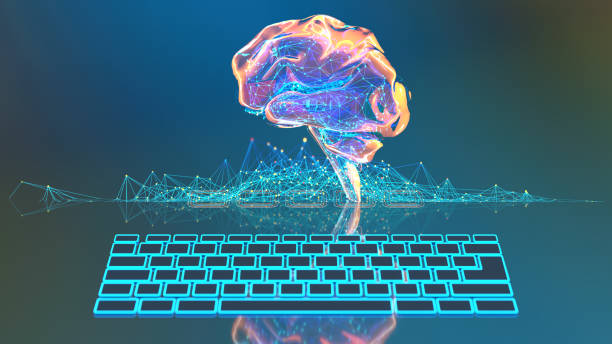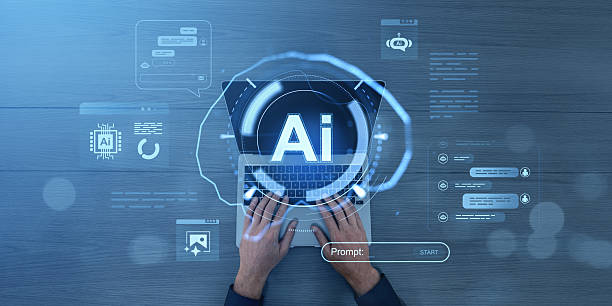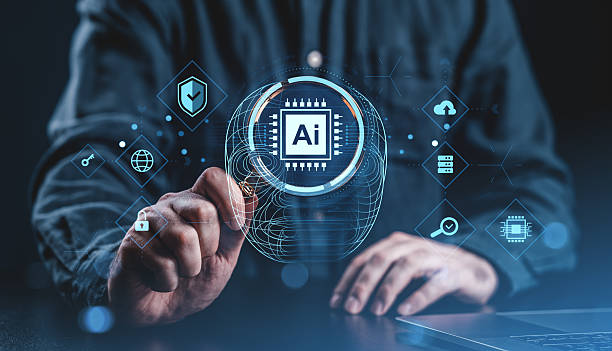Introduction to the Importance of Website Design with Modern User Interface

In today’s digital world, where competition is fierce and user attention is limited, #Website_design with a modern user interface is no longer a luxury option, but an undeniable necessity for any business that wants to shine in the online space.
A modern User Interface (UI), beyond visual aesthetics, means creating an unparalleled User Experience (UX) that captivates users and guides them towards the website’s goals, whether it’s purchasing a product, filling out a form, or reading content.
This approach makes your website not only beautiful but also exceptionally functional and #user-friendly.
The question is, how can this level of design be achieved? This chapter, as an explanatory section, delves into this fundamental concept and why it is important in the web ecosystem.
Designing a website with a modern user interface not only helps improve conversion rates but also increases user loyalty and strengthens your brand in the long term.
When a user can easily find what they are looking for and enjoy interacting with your website, the probability of them returning to the website and becoming a loyal customer significantly increases.
Optimizing user interface and user experience is the key to success in digital marketing.
Does your current website convert visitors into customers or drive them away? Solve this problem forever with professional corporate website design by Rasaweb!
✅ Build strong credibility and branding
✅ Attract target customers and increase sales
⚡ Get a free consultation right now!
Key Principles of Modern User Interface Design

To achieve truly effective website design with a modern user interface, specific principles must be followed.
These principles, which have a specialized and guiding aspect, include simplicity, consistency, instant feedback, and intuitiveness.
Simplicity means removing unnecessary elements and focusing on what the user needs; this allows the user to reach their goal without confusion.
Consistency means maintaining a constant appearance and functionality across all pages and sections of the website to ensure a uniform and predictable user experience.
Instant feedback assures users that their actions are being processed, for example, by displaying a loading indicator or changing a button’s color after a click.
Intuitiveness means that users can interact with the website and understand the function of various sections without needing special training or guidance.
Furthermore, Responsive Design is an inseparable principle of modern user interface website design, because today’s users access websites from various devices, and the website must have consistent performance and appearance on every screen size.
Adhering to these principles greatly contributes not only to beauty but also to efficiency and end-user satisfaction.
New Tools and Technologies in Web Design

The world of web design is constantly evolving, with new tools continuously being introduced to assist designers and developers.
In modern user interface website design, using the right tools can make a significant difference in the quality and speed of work.
For the design phase, software like Figma, Sketch, and Adobe XD are recognized as industry standards.
These tools offer powerful features for wireframing, prototyping, and team collaboration.
In the development section, JavaScript frameworks such as React, Vue, and Angular help developers build complex and interactive user interfaces with less code and greater efficiency.
Additionally, CSS frameworks like Tailwind CSS and Bootstrap also accelerate the process of designing and implementing the website’s appearance.
The combined use of these tools and technologies facilitates achieving modern and responsive website design with a modern user interface.
This section has an educational and specialized aspect, introducing top options in this field.
These tools not only increase productivity but also provide designers with more creative possibilities to create attractive and functional visual experiences.
| Category | Tool/Framework Name | Main Use | Key Feature |
|---|---|---|---|
| UI/UX Design Tools | Figma | UI Design, Prototyping, Online Collaboration | Web-based, Real-time Collaboration |
| UI/UX Design Tools | Sketch | UI Design, Icon Creation | macOS Only, Rich Plugin Ecosystem |
| UI/UX Design Tools | Adobe XD | Design, Prototyping, Animation | Integration with Adobe Products |
| JavaScript Frameworks | React | Building Single-Page User Interfaces | Component-based, Powerful Library |
| JavaScript Frameworks | Vue.js | Building Progressive and Simple User Interfaces | Easy to Learn, Lightweight, Flexible |
| JavaScript Frameworks | Angular | Developing Large and Complex Applications | Full-fledged Framework, Google Support |
The Impact of User Experience on Business Success
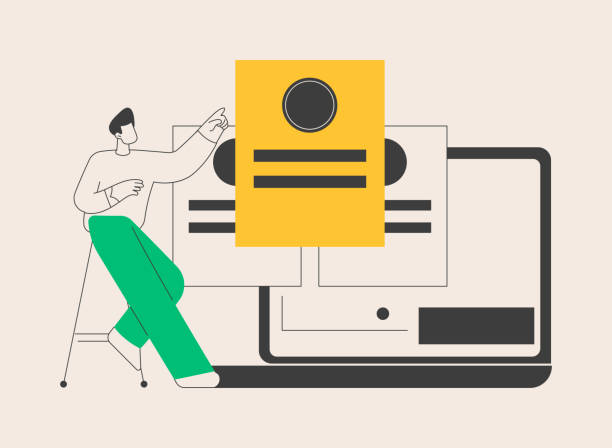
User Experience (UX), as the heart of modern user interface website design, is not merely a technical concept but a vital factor in the success or failure of online businesses.
Poor UX can lead to high bounce rates, decreased user engagement, and ultimately, loss of customers.
Conversely, a strong user experience not only makes users stay on your site longer but also converts them into loyal customers.
From an analytical and news perspective, data shows that companies investing in UX improvement have seen significant increases in conversion rates, customer satisfaction, and even brand value.
For instance, major tech companies like Apple and Google largely owe their reputation to their obsessive focus on the user experience of their products.
They know that modern UI website design and flawless UX can guarantee customer loyalty.
This investment yields high returns, which is why user experience design has become one of the hottest topics in the industry.
This trend signifies a shift in perspective from mere aesthetics towards functionality and efficiency, where good design directly contributes to business profitability.
Are you tired of your e-commerce website not generating as much revenue as it could? Rasaweb, specializing in professional e-commerce website design, solves this problem forever!
✅ Increase sales rate and revenue
✅ High loading speed and unparalleled user experience
⚡ Get a free e-commerce website design consultation
Challenges of Implementing Modern User Interface
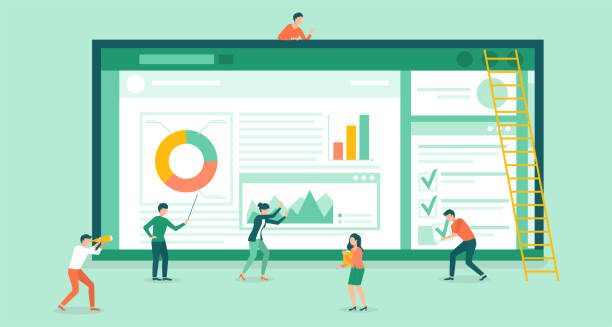
Implementing a modern user interface website design, while offering numerous benefits, is not without its challenges.
One of the biggest questions is how to combine aesthetics with optimal website performance and speed. Often, complex visual designs and attractive animations can negatively impact page loading speed, which in turn disrupts the user experience.
Another important challenge is the issue of Accessibility; is your design usable for all users, including those with disabilities? This is a debatable yet specialized topic that requires special attention.
Ongoing maintenance and updates of the user interface to keep up with the latest trends and technologies can also be costly and time-consuming.
Designers must strike a delicate balance between innovation and stability to prevent their design from quickly becoming outdated, without sacrificing website performance.
These issues indicate that modern user interface website design is not just about choosing beautiful fonts and colors, but a complex and continuous process that requires meticulous planning and a deep understanding of user needs.
Responsive Design and Mobile-First Approach
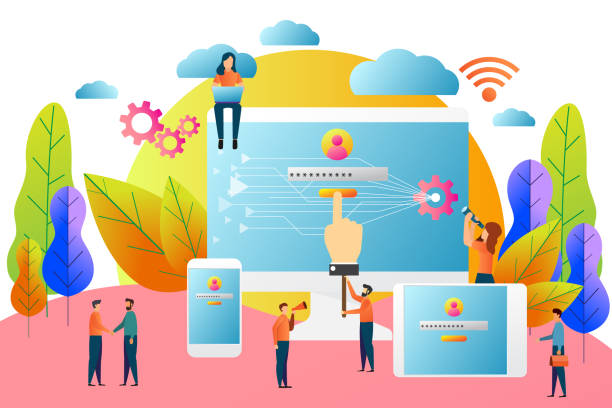
Given the increasing use of mobile devices to access the internet, Responsive Design and the Mobile-First approach have become essential components of modern user interface website design.
This section provides practical and explanatory guidance for understanding these concepts.
Responsive design means that your website should automatically adapt its size and layout to any screen size, from large desktops to tablets and smartphones.
This ensures that users have an optimal experience regardless of the device they use.
The mobile-first approach goes a step further; in this method, designers first design the mobile version of the website and then develop it for larger screens.
This approach ensures that core functionality and content are accessible and optimized even on the smallest screen.
This is not only crucial for user experience, but Google also prioritizes mobile-friendly websites in its search rankings.
Adhering to these principles in modern user interface website design ensures that your website is future-proof and can serve a wide range of users.
Future Trends in UI/UX Design

The world of UI/UX design is constantly changing, and anticipating future trends is crucial for anyone involved in modern user interface website design.
This section delves into analytical and news aspects, examining some of the most important upcoming trends in this field.
One significant trend is the increasing use of Voice User Interface (VUI), where users can interact with websites and applications through voice commands.
Artificial Intelligence (AI) will also play an increasing role in personalizing user experience and even automating parts of the design process.
Augmented Reality (AR) and Virtual Reality (VR) are also finding their place in web design and can bring entirely new experiences to users.
These technologies are pushing the boundaries of modern user interface website design, and designers must be ready to adopt and integrate them into their work.
Furthermore, focusing on cognitive design and anticipating user needs before they even realize them is emerging as an important trend.
These developments indicate that the future of UI/UX is moving towards more natural, intelligent, and immersive interactions.
| Trend | Description | Impact on User Experience |
|---|---|---|
| Voice User Interface (VUI) | Interaction with the system via voice commands | Greater convenience, improved accessibility |
| AI in Design | Content personalization, automated design (AI-powered design tools) | Personalized user experience, greater design efficiency |
| Augmented Reality (AR) and Virtual Reality (VR) | Creating immersive and interactive experiences | Deeper interactions, novel applications in sales and education |
| Microinteractions | Small animations and feedback during interaction | Increased engagement and sense of efficiency, improved understanding of functionality |
| Dark Mode | Support for dark theme to reduce eye strain | Visual comfort in low-light environments, extended battery life |
Case Studies of Successful Modern User Interface Implementations

To better understand how to achieve successful modern user interface website design, examining real-world examples can be very engaging and illustrative.
Websites like Airbnb, Spotify, and Dropbox are prime examples of companies leading the way in UI/UX design.
Airbnb, with its intuitive user interface and attractive imagery, has simplified the process of searching and booking accommodations for millions of users worldwide.
Spotify, by providing a personalized user experience and minimalist visual design, has become the gold standard for music streaming platforms.
Dropbox has also made file management and team collaboration extremely easy by focusing on simplicity and efficiency.
These companies are not only visually appealing but are constantly testing and optimizing their user interfaces based on user feedback and analytical data.
Their success demonstrates that modern user interface website design that responds to user needs and creates an enjoyable experience can lead to significant business growth.
This case study is inspiring and shows how user-centric focus can lead to extraordinary results.
Does your current website showcase your brand’s credibility as it should? Or does it drive away potential customers?
Rasaweb, with years of experience in professional corporate website design, is your comprehensive solution.
✅ A modern, beautiful website tailored to your brand identity
✅ Significant increase in lead generation and new customer acquisition
⚡ Contact Rasaweb now for a free corporate website design consultation!
Measuring the Effectiveness of Modern User Interface

After implementing a modern user interface website design, how can its effectiveness be ensured? This section provides expert guidance on measurement metrics and evaluation methods.
Metrics such as Bounce Rate, Time on Site, Conversion Rate, and Task Completion Rate are crucial tools for evaluating UI/UX performance.
Low bounce rate and high time on site usually indicate an engaging user interface and relevant content.
A high conversion rate directly refers to the website’s ability to convert visitors into customers or desired actions.
Tools like Google Analytics, Hotjar, and Optimizely allow designers and marketers to track user behavior and identify the strengths and weaknesses of their design.
A/B testing, Heatmaps, and Session Recordings are also valuable methods for collecting qualitative and quantitative data.
Regular user testing and direct feedback collection from users are also essential for continuous improvement of modern user interface website design.
This measurement and improvement process is a continuous cycle that helps your website remain up-to-date and efficient.
Conclusion and Next Steps for Web Designers

As explored in this extensive educational and guiding article, modern user interface website design goes beyond a beautiful appearance; it means creating an unparalleled and functional user experience that helps achieve your business goals.
We examined key principles, new tools and technologies, the impact of UX on business success, challenges, the importance of responsive design, and future trends.
For web designers, this field requires continuous learning and updating of knowledge and skills.
It is recommended to always focus on the user, analyze data, and use user feedback for continuous improvement.
With the emergence of new technologies and changing user expectations, modern user interface website design will remain a dynamic and exciting field.
Your next step is to put this knowledge into practice; work with new tools, participate in real projects, and learn from your own mistakes and those of others.
Only through practical experience and commitment to continuous improvement can you become a successful web designer in this field and create websites that are not only beautiful but truly help users and businesses achieve their goals.
Frequently Asked Questions
| Row | Question | Answer |
|---|---|---|
| 1 | What does Modern UI in website design mean? | Modern UI means designing websites with a minimalist look, extensive use of white space, clear typography, vibrant colors or cohesive palettes, subtle animations, and a focus on visual and intuitive User Experience (UX). |
| 2 | What features make a user interface “modern”? | Key features include responsive design, smooth animations, use of vectors and SVG icons, prominent typography, sufficient white space, creative layering, harmonious colors, and a focus on accessibility. |
| 3 | What is the importance of Responsive Design in modern user interface? | Responsive design ensures that the website displays correctly on any device (mobile, tablet, desktop) and provides a consistent user experience, which is one of the fundamental principles of modern user interface. |
| 4 | Why is the use of White Space important in modern design? | White space or “negative space” helps text and other elements breathe and be distinguishable, increases readability, enhances user focus on the main content, and creates a clean and professional appearance. |
| 5 | What is the role of animations and micro-interactions in modern user interface? | Animations and micro-interactions (small interactions) make the user experience more dynamic and engaging, provide feedback to the user, improve navigation flow, and add a sense of quality and polish to the design. |
| 6 | What is the place of typography in modern website design? | Typography plays a very important role in modern design; appropriate fonts, size, weight, and correct spacing improve readability and can impart a specific mood and character to the brand. |
| 7 | How can visual consistency be achieved in modern design? | By using a Design System, a limited and specific color palette, consistent typography, reusable UI components, and maintaining uniformity in spacing between elements and visual rhythm. |
| 8 | What is the relationship between User Experience (UX) and modern User Interface (UI)? | The User Interface (UI) is the visual and interactive part of a product, while User Experience (UX) relates to the user’s overall feeling when using the product. A modern UI should contribute to improving UX and, beyond visual aesthetics, be functional and intuitive. |
| 9 | What are some common trends in modern user interface design? | Trends include Dark Mode, Neumorphism, Glassmorphism, large and prominent typography, use of gradients, 3D images, and Lottie animations. |
| 10 | What are the main challenges in modern user interface website design? | Challenges include maintaining simplicity while innovating, ensuring Accessibility, optimizing loading speed despite heavy animations and images, and maintaining a balance between aesthetics and functionality. |
And other services of Rasaweb Advertising Agency in the field of advertising
Smart Direct Marketing: A new service for increasing digital branding through key page optimization.
Smart Marketing Automation: A new service for increasing click-through rates through attractive UI design.
Smart Custom Software: A combination of creativity and technology for campaign management through attractive UI design.
Smart Reportage: A creative platform for improving SEO ranking using real data.
Smart Sales Automation: A fast and efficient solution for increasing click-through rates with a focus on marketing automation.
And over hundreds of other services in the field of internet advertising, advertising consultation, and organizational solutions
Internet Advertising | Advertising Strategy | Advertorial
Sources
Secrets of Modern UI Design
Articles: Successful Web User Interface
Modern Website UI Design Tips
Success Factors in UX/UI
? Rasaweb Afarin Digital Marketing Agency is your trusted partner on the path to digital growth and achieving your business goals. From custom website design to SEO optimization and advertising campaign management, we are by your side to ensure a powerful online presence.
📍 Tehran, Mirdamad Street, next to Bank Markazi, Southern Kazeroon Alley, Ramin Alley, No. 6


